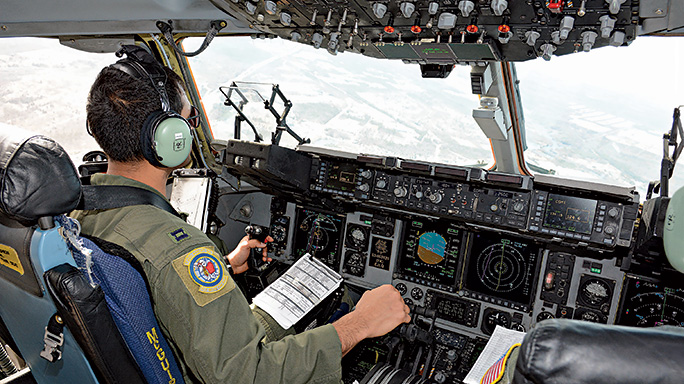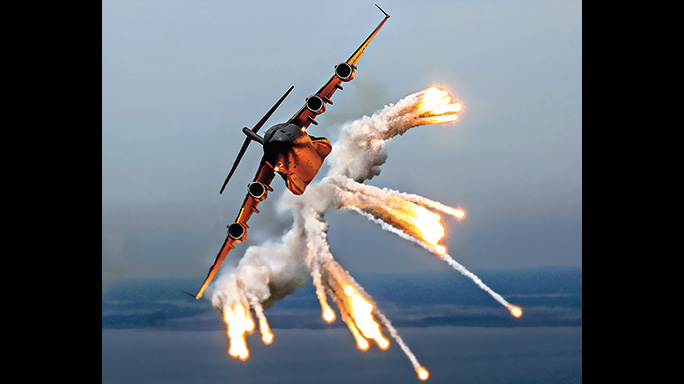When the U.S. military wants to load up and move out, or the U.S. Secret Service needs to move the President’s limos, or aid needs to be shipped to nations in need—they all make one call to the nearest U.S. Air Force C-17 Globemaster III.
- RELATED STORY: Special Ops: The Ghosts of HALO Parachuting
According to Boeing, “In the early 1970s, there was a push to modernize the U.S. air fleet, which included mission specifications that required the new aircraft to be capable of transporting supplies faster and closer to the frontlines, with the capability of performing short takeoffs and landings from runways in rough terrain.”
After many iterations, on Sept. 15, 1991, with stronger engines, swept wings and a larger cargo area, the C-17 made its first flight as the most advanced airlifter ever made and became the U.S. Air Force’s premier transport platform.
Advertisement — Continue Reading Below
Boeing later said, “During flight testing at Edwards Air Force Base in California, the C-17 set 33 world records—more than any other airlifter in history. Since its first flight, the C-17 has exceeded 2 million fight hours and has supported both combat operations and humanitarian relief efforts in Pakistan, Haiti, Chile, China, Myanmar and Thailand.
Aboard Jedi 11
On March 22, I was lucky to set foot inside a C-17 at Joint Base McGuire-Dix-Lakehurst in New Jersey as a guest of the 732nd Airlift Squadron, whose motto is “Fly with the ram.” The squadron, a USAF Reserve unit that is part of the 514th Air Mobility Wing, is commanded by Lieutenant Colonel Samuel Irvin. Irvin has been flying C-17s for over 10 years, and in his civilian job he flies Boeing 777s for United Airlines
Advertisement — Continue Reading Below
Irvin said, “The C-17 is one of the best assets the Air Mobility Command has at its disposal. It can perform almost every mission set we have compared to other aircraft, and in my opinion is the best bang for the buck for the taxpayer.”
The crew was comprised of several USAF Reserve pilots, including Captain Justin Paulson, First Lieutenant Tommy Beltz, Captain Kyle Johnson, Captain Lee Schmeer and Master Sergeant Thomas Shine, the primary “load master.” This flight was unique due to it being a mission evaluation for Captain Paulson. This meant the plane would go through many of its performance capabilities, including short takeoff and landing operations, low-flight operations, tactical arrivals and departures, and in-flight refueling.
As we walked the tarmac to the plane, Captain Paulson, who gave the crew brief, said, “I was active duty in the Air Force for eight years and just got into the Reserves. I’ve flown almost every mission with the C-17 that it can perform, and to this day, it’s still an amazing aircraft.”
Advertisement — Continue Reading Below
As we walked down the tarmac to our ride, the aircraft grew from big to larger than life. Arriving on board was literally walking into the heartbeat of U.S. military prowess, and few other assets in the military, let alone the U.S. government, are as reliable and versatile as the C-17.
Heavy Lifter
The plane’s cargo area can carry a lot of equipment, including up to 102 paratroopers. With a maximum payload capacity of 170,900 pounds and a maximum gross takeoff weight of 585,000 pounds, the C-17 can move anything that can fit inside it. This includes carrying a cargo of wheeled U.S. Army vehicles in two side-by-side rows, such the U.S. Army’s main battle tank, the M1, or three Bradley infantry fighting vehicles.
Advertisement — Continue Reading Below
With a typical cruise altitude of 31,000 feet, a cruise speed of 450 knots and a range of around 4,500 nautical miles prior to fueling, the plane can reach out and touch almost any destination in the world with minimal refuels. The C-17 ‘s ability to take off, land, backup and perform a three-point star turn on runways as short as 3,500 feet and only 90 feet wide is an amazing feat for a plane of its size.
As we strapped into one of the jump seats in the cargo area, we heard the engines roar to life as the Globemaster started rolling down the taxiway. Displaying the full power of the C-17’s engines, within seconds we ascended into the sky in a high arc.
The gigantic cargo bay can transform into many different configurations. According to Master Sergeant Shine, the “load master” on this flight, “Our main focus is to ensure the safety of the flight. The C-17 cargo compartment is a versatile area, and it usually takes about two hours to transform the load area into one of its many configurations.”
Advertisement — Continue Reading Below
The plane can handle 18 pallet positions with four additional on the ramp. The C-17 Globemaster III can also airdrop a single load up to 60,000 pounds, sequential loads of up to 110,000 pounds, 40 containers that weigh up to 2,350 pounds each, or 102 paratroopers on a target.
“For medevac missions, we are able to transport up to 36 litter and 54 ambulatory patients and attendants, transforming us into an air hospital,” Shine said. “For us, the most rewarding missions we perform are medevacs, especially when we have to get our troops back safely from downrange. That’s when we can see that we really make a difference.”
The C-17 is also equipped with counter-measures, including jammers. The system interfaces to the C-17’s sensors, and the crew can reportedly select the mode of operation of the countermeasure dispenser for fully automatic, semi-automatic or manual operation. Bottom line: The plane can fly and protect itself with some of the most advanced technology on the market.
Advertisement — Continue Reading Below
Force Of The Jedi
On this particular day, the pilots flew to the Lakehurst Naval side of the Joint Base and commenced practicing short-distance landings and takeoffs. Lieutenant Colonel Irvin said, “To become qualified, the pilot has to land the plane in a 500-foot box and stop within 3,500 feet. Once that’s accomplished, they need to be able to get the plane off the ground in as little as 3,500 feet and tactically accelerate the jet and climb to a few thousand feet to minimize the time when the aircraft is exposed to small-arms fire.”
The pilots also practiced low-altitude flying at 500 feet. Irvin explained, “Low-altitude operations with the C-17 Globemaster III are particularly tricky due to the size and wingspan of the aircraft, low-altitude obstacles like towers and civilian aircraft, but it’s a crucial operation to ingress and egress airfields at low altitude to reduce exposure to air defenses.”
Advertisement — Continue Reading Below
From our perspective, the most challenging part of the flight appeared to be the aerial refueling. “Today we actually have a clear day with great air,” Irvin said. “Like everything, though, this is why we practice this and every other maneuver. Perfect practice makes perfect flying—the more reps you get in, the easier it will be in a real-word evolution.”
From the cockpit, we watched the pilot, Captain Paulson, and his co-pilot, Captain Kyle Johnson, deftly maneuver the C-17 underneath a KC-10 with its refueling boom extended. It takes a steady hand because the pilots have to line up just under and behind the refueler and then gauge air speed, distance and altitude to connect with the boom. The pilots were fully focused on hitting their target, and for a large aircraft, it seemed like they were moving the plane in inches versus feet.
“Aerial refueling is only accomplished by planning a pre-determined location, altitude, distance and air speed. Of course, the optimal time to perform this type of evolution is during daylight hours, but we also practice at night, which can be a lot more challenging,” Irvin said.
Advertisement — Continue Reading Below
- RELATED STORY: Combat Vehicles: Sikorsky’s SB-1 Defiant Helicopter
Turning back toward Joint Base McGuire, the crew executed a high-altitude tactical arrival, which avoids low-altitude flight in hot airspace, reducing exposure to small-arms fire. Once ready to land, First Lieutenant Tommy Belts called the tower and said, “Jedi 11 gear down,” as the plane’s main wheels made contact with the tarmac and the engines went into full reverse, stopping the plane in about 1,500 feet.
After parking the C-17, Irvin congratulated Captain Paulson on a great flight, thus completing his evaluation on one of the most technologically advanced aircraft in the world, but it takes a crew like the Jedi 11’s to make it actually perform.





























